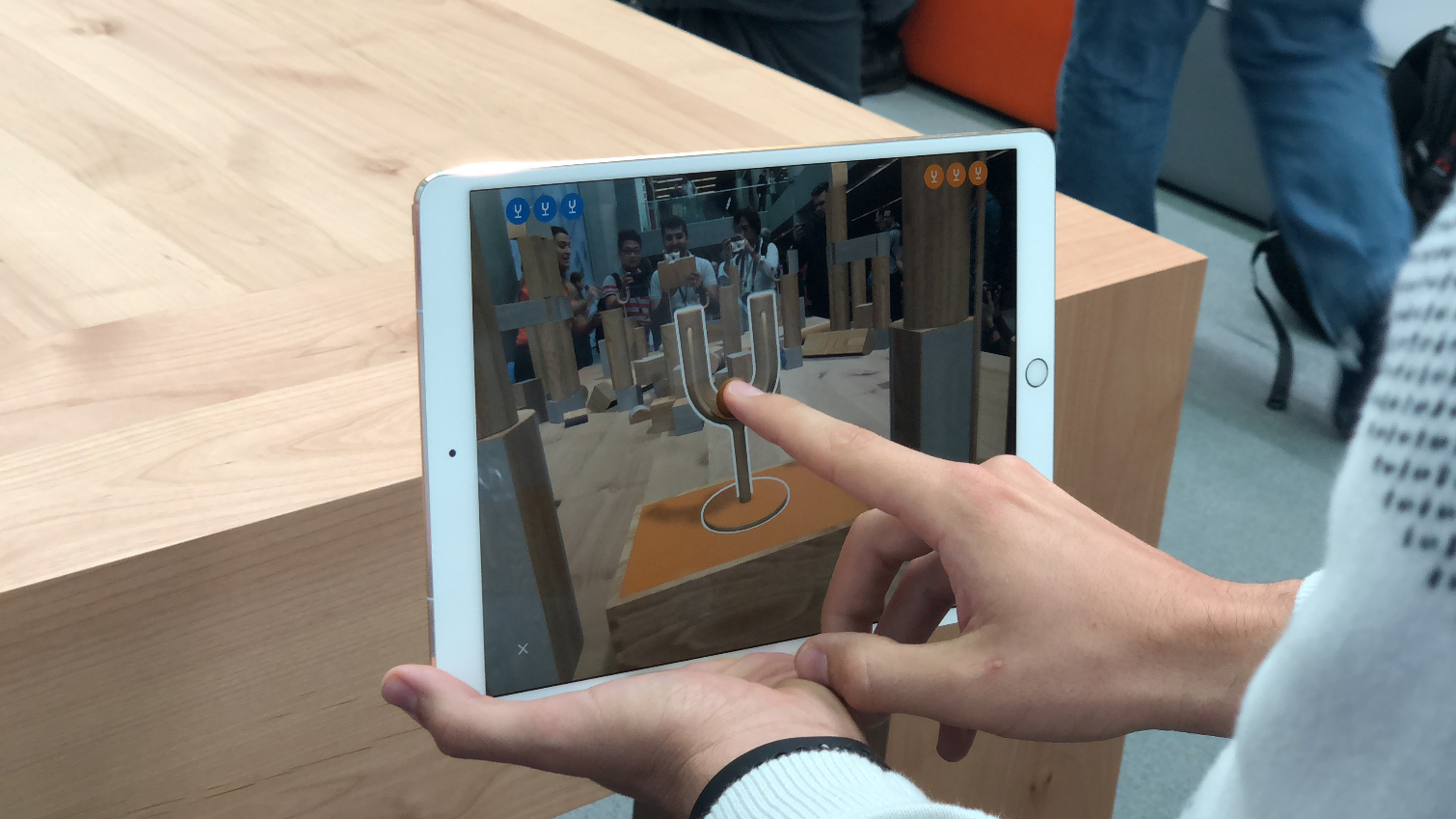Apple's ARKit 2 Is a Leap Forward, But Something's Missing
The promise of shared AR experiences in ARKit is exciting, but Apple still has a long way to go towards making augmented reality more than a novelty.
The AR revolution is here. Almost.
That's what popped into my head as I experienced my first live demo of ARKit 2, the new augmented reality platform Apple is launching alongside iOS 12. ARKit 2 features several notable enhancements, including the ability for developers to create shared AR experiences.

Picture a blank table transformed into a battleground using two iPads, one held by two opponents on opposite sides. The app enables you to activate a virtual slingshot that knocks down the blocks of the other player. There was also a spectator mode broadcast on nearby TV, so others could watch the action.
"ARKit 2 takes AR to a new level and opens up new use cases. Think about education or training in a group." — Carolina Milanesi, Creative Strategies
The game was somewhat amusing, but it was mostly about showcasing the potential of ARKit 2 once developers get their hands on it.
"ARKit 2 takes AR to a new level and opens up new use cases," said Carolina Milanesi, principal analyst for Creative Strategies. "Today [Apple] showed a shared game but think about education or training in a group rather than individual people. It does increase the appeal both from the user side and the developer side."
One of the first developers to embrace ARKit 2 is Lego, which has an AR City app on the way that taps into ARKit 2's 3D object detection capabilities and persistent AR. The latter feature enables players to pick up right where they left off the next time they play.
AR City is definitely cute. You can drop characters right into a 3D world and have adventures with friends who want to play along. As you zoom in, you'll see items highlighted that you can activate. But I also wonder how long kids will want to hold their iPhones and iPads aloft to play games like this. They'll be much more compelling when Apple is able to deliver an AR headset, as it's been rumored to be developing.
Get instant access to breaking news, the hottest reviews, great deals and helpful tips.

"Apple’s investments in ARKit today are creating a massive installed base for when wearable AR is ready," said Avi Greengart, research director for consumer platforms and devices at GlobalData.
"Apple’s investments in ARKit today are creating a massive installed base for when wearable AR is ready." — Avi Greengart, GlobalData
Apple also announced its own Measure app for iOS 12, which lets you turn your iPhone or iPad into a digital tape measure. Apple says the app automatically provides the dimensions of various objects like picture frames, posters and signs. If you're measuring something like luggage, you tap the object and start dragging a line to get the measurement.

"Apple took an app that was almost the showcase of AR and they elevated [it]," said Milanesi. "It is not just about measuring, but they showed calculating the surface of what they were measuring. It is almost showing how to build on top of basic AR by using other tools like AI."
Measure isn't a killer app, but by offering it in iOS 12, Apple will be able to expose a lot more people to augmented reality. And that exposure should lead to curiosity around what other iOS AR apps are available.
One of the more compelling AR apps I've seen is Chalk, which lets you draw on someone else's live view in real time. It's a handy app for things like performing tech support for someone else remotely, drawing directly on their camera view.
But beyond that I just haven't seen that many gotta-have AR apps. Really, there's no killer app for this still-nascent category.
Overall, ARKit 2 is an important evolutionary step for augmented reality, but 2018 still doesn't feel like the year for AR.
Part of Apple's strategy is sprinkling AR into apps you already use, and it's doing that with a new usdz file format the company developed in collaboration with Pixar. For example, you might be able to place that chair you're shopping for in a Safari app and then place it right into your living room via AR.
"The new file format is important as it widens the use cases, allows [people] to create more content and expands usage outside of specific apps," Milanesi said.
Overall, ARKit 2 is an important evolutionary step for augmented reality, but 2018 still doesn't feel like the year for AR. It's going to take not just killer new apps for the iPhone and iPad but a new wave of hardware to make those shared experiences to feel as seamless as we want them to be.
"It is great to see Apple continuing to push AR forward – shared experiences and creating a common file format are foundational features," Greengart said. "However, mobile AR does not feel essential yet."
Mark Spoonauer is the global editor in chief of Tom's Guide and has covered technology for over 20 years. In addition to overseeing the direction of Tom's Guide, Mark specializes in covering all things mobile, having reviewed dozens of smartphones and other gadgets. He has spoken at key industry events and appears regularly on TV to discuss the latest trends, including Cheddar, Fox Business and other outlets. Mark was previously editor in chief of Laptop Mag, and his work has appeared in Wired, Popular Science and Inc. Follow him on Twitter at @mspoonauer.

